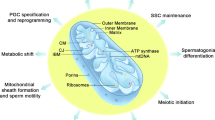Abstract
An oocyte in Drosophila melanogaster originates from 1 of 16 cells comprising an ovarial syncytium. The two pro-oocytes proceed into the pachytene stage of meiosis, but only one develops further into a mature oocyte while the other reverts to a nurse cell. It is known that pro-nurse cells also enter meiosis, as they contain incomplete synaptonemal complexes (SCs). We now show that these cells also harbour recombination nodules (RNs). In cells that only occasionally contain SC segments, the RNs are typically not located close to distinct tripartite SC structures. Instead, these RNs are frequently associated with a spherical body of amorphous material and two to three, more or less parallel fibres, possibly representing SC material. The significance of the solitary RNs is discussed in relation to the present knowledge of the assembly and disassembly of the SC.
Similar content being viewed by others
References
Albini SM, Jones GH (1987) Synaptonemal complex spreadings in Allium cepa and A. fistulosum. I. The initiation and sequence of pairing. Chromosoma 95:324–338
Bishop DK, Park D, Xu Liuzhong, Kleckner N (1992) DMC 1. A meiosis-specific yeast homolog of E. coli rec A required for recombination, synaptonemal complex formation, and cell cycle progression. Cell 69:439–456
Carpenter ATC (1975a) Electron microscopy of meiosis in Drosophila melanogaster females. I. Structure, arrangement, and temporal changes of the synaptonemal complex in wild-type. Chromosoma 51:157–182
Carpenter ATC (1975b) Electron microscopy of meisois in Drosophila melanogaster females. II. The recombination nodule —a recombination-associated structure at pachytene? Proc Natl Acad Sci USA 72:3186–3189
Carpenter ATC (1979a) Synaptonemal complex and recombination nodules in wild-type Drosophila melanogaster females. Genetics 92:511–541
Carpenter ATC (1979b) Recombination nodules and synptonemal complex in recombination-defective females of Drosophila melanogaster. Chromosoma 75:259–292
Carpenter ATC (1981) EM autoradiographic evidence that DNA synthesis occurs at recombination nodules during meiosis in Drosophila melanogaster females. Chromosoma 83:59–80
Carpenter ATC (1987) Gene conversion, recombination nodules, and the initiation of meiotic synapsis. BioEssays 6:232–236
King RC (1970) Ovarian development in Drosophila melanogaster. Academic Press, New York
Koch EA, Smith PA, King RC (1967) The division and differentiation of Drosophila cystocytes. J Morphol 121:55–70
Moens PB, Rapport E (1971) Synaptic structures in the nuclei of sporulating yeast, Saccharomyces cerevisiae (Hansen). J Cell Sci 9:665–677
Padmore P, Cao L, Kleckner N (1991) Temporal comparison of recombination and synaptonemal complex formation during meiosis in S. cerevisiae. Cell 66:1239–1256
Rasmussen SW (1974) Studies on the development and ultrastructure of the synaptonemal complex in Drosophila melanogaster. CR Trav Carlsberg 39:443–468
Rasmussen SW (1976) The meiotic prophase in Bombyx mori females analyzed by three-dimensional reconstructions of synaptonemal complexes. Chromosoma 54:245–293
Roth TF (1966) Changes in the synpatonemal complex during meiotic prophase in mosquito oocytes. Protoplasma 61:346–386
Stack SM, Anderson LK (1986) Two-dimensional spreads of synaptonemal complexes from solanaceous plants. II. Synapsis in Lycopersicon esculentum (tomato). Am J Bot 73:264–281
Wandall A, Svendsen A (1985) Transition from somatic to meiotic paring and progressional changes of the synaptonemal complex in spermatocytes of Aedes aegypti. Chromosoma 92:254–264
von Wettstein D (1977) The assembly of the synaptonemal complex. Philos Trans R Soc Lond [Biol] 277:235–243
Author information
Authors and Affiliations
Additional information
Communicated by: P.B. Moens
Rights and permissions
About this article
Cite this article
Schmekel, K., Wahrman, J. & Daneholt, B. Solitary and synaptonemal complex-associated recombination nodules in pro-nurse cells during oogenesis in Drosophila melanogaster . Chromosoma 102, 396–402 (1993). https://doi.org/10.1007/BF00360404
Received:
Revised:
Accepted:
Issue Date:
DOI: https://doi.org/10.1007/BF00360404




